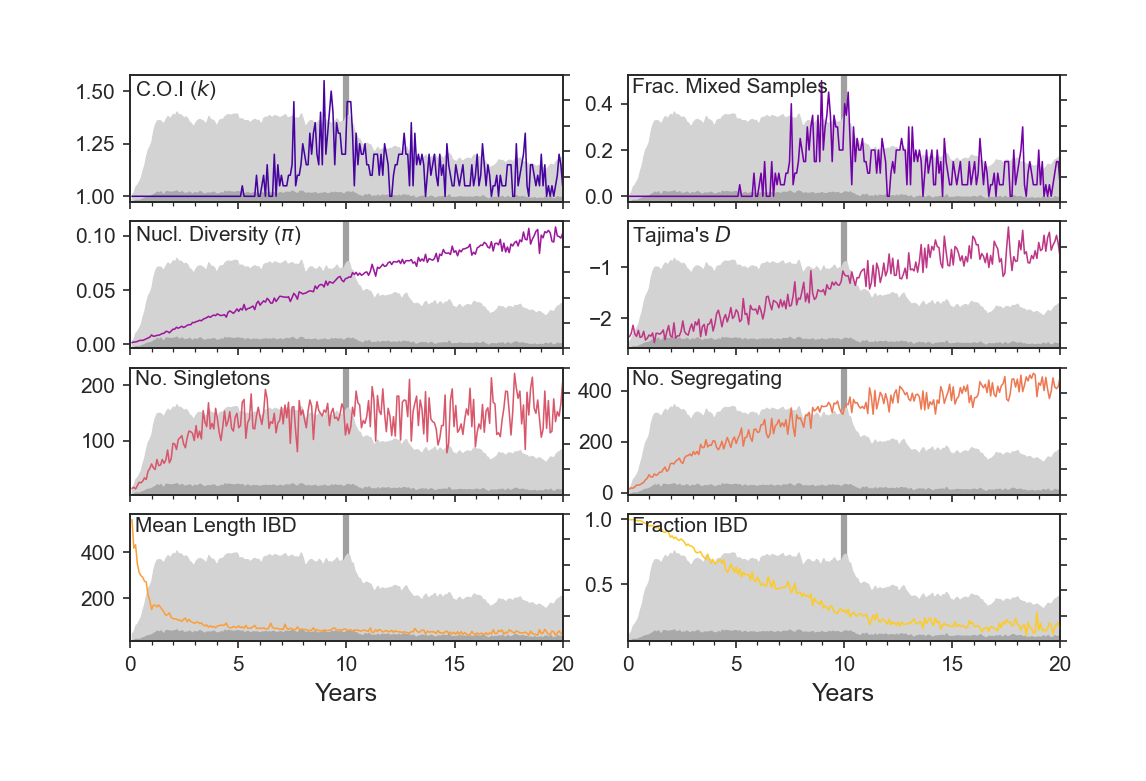A forward-time simulation of malaria transmission and evolution: including drift, recolonisation, extinction, admixture and meiosis.
forward-dream is implemented in python and the dependencies can be installed using conda:
git clone https://github.com/JasonAHendry/fwd-dream.git
cd fwd-dream
conda env create
conda activate dream
First, activate the conda environment:
conda activate dream
Then, in the /fwd-dream directory, run:
python simulation.py -e <expt_name> -p <params/param_set.ini>
The -e flag specifies your experiment name, e.g. -e high-transmission.
The -p flag gives the path to your parameter set, which is an .ini file in the /params directory. In brief, this is how you set all the model parameters for forward-dream, and also how you specify different "Epochs" -- i.e. change parameter values during a simulation. See /params/README.txt for more details.
The simulation will run printing diagnostics to stdout in your terminal. Outputs will be deposited in /results/<expt_name>. In particular, op.csv will contain information about prevalence of hosts and vectors during the simulation, and og.csv will contain information about the genetic diversity of the parasite population.
I've included an example parameter set (params/param_default-example.ini) and notebook (notebooks/sec0_plot-default-example.ipynb) for you to get started with forward-dream. The parameters are set such that the simulation runs with default parameters, but for only 20 years, such that you can run the simulation in a couple minutes on your local machine. To run it, navigate to the /fwd-dream directory and run:
conda activate dream
python simulation.py -e default -p params/param_default-example.ini
The simulation should now print some diagnostics to stdout. Once the simulation is done, you should be able to run the notebook notebooks/sec0_plot-default-example.ipynb to produce plots that recreate Figure 2 of the forward-dream manuscript:
Note that twenty years is not enough time for the population to reach genetic equilibrium.
Below I describe the workflows I used to run the experiments described in the forward-dream manuscript. The workflows are specific to the BMRC computer cluster at the University of Oxford. If you plan on re-running these experiments you will likely have to tailor these workflows to your specific cluster setup.
One application of foward-dream is to look at differences in parasite genetic diversity at equilibrium, under different host prevalence regimes. Since we are often unsure of what drives host prevalence variation from region to region, we explore varying host prevalence by changing either (i) the vector biting rate, (ii) the vector density, or (iii) the average duration of infection.
sshonto the BMRC cluster.- Create a base parameter set in the
paramsdirectory.
- Except for the parameter that is modulated to drive variation in prevalence, the parameters in this file will be held fixed across experiments.
- The
Epochsin this file will also be held fixed across experiments.
- Run
gen_correlation-experiment.py -e <expt_name> -p <params/param_file.ini> -n <n_reps>, setting the-pflag to your base parameter set.
- This will generate three files:
submit_correlation-nv.sh,submit_correlation-gamma.sh, andsubmit_correlation-br.sh
- Source the submission files to submit jobs to the cluster, e.g.
./submit_intervention-nv.sh.
Another application of forward-dream is to explore how genetic diversity statistics behave in non-equilibrium contexts, for example following malaria control interventions. We simulate interventions by changing different simulation parameters, and then follow how a suite of genetic diversity statistics change through time.
sshonto the BMRC cluster.- Create a base parameter set for your intervention experiment in the
paramsdirectory.
- Except for the parameter that is modulated to drive variation in prevalence, the parameters in this file will be held fixed across experiments.
- The
Epochsin this file will also be held fixed across experiments.
- Run
gen_intervention-experiment.py -e <expt_name> -p <params/param_file.ini> -n <n_reps>, setting the-pflag to your base parameter set.
- This will generate three new parameter files:
params_insecticide.ini,params_artemisinin.ini, andparams_bednets.ini - It will also generate three submission files:
submit_intervention-nv.sh,submit_intervention-gamma.sh, andsubmit_intervention-br.sh
- Source the submission files to submit jobs to the cluster, e.g.
./submit_intervention-nv.sh.

